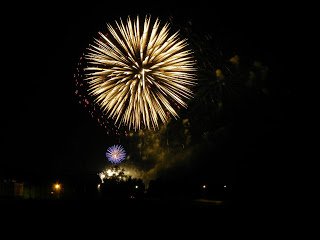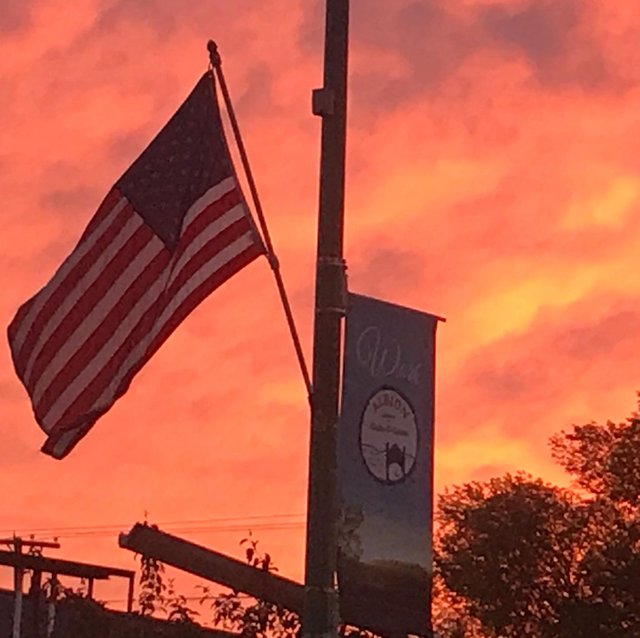This is the tenth anniversary of one of my favorite blogs, and also of this one. I reran it a few years ago, but few people read it because it's about history. As I said in the opening to our book "Hoosier Hysterical", history would be a lot more fun if it was made ... well ... fun. So I had fun with this. (It's been changed slightly, because I'm older.)
Ever since Christopher Columbus first landed in the New World and hid all the Viking artifacts, America has been a land of opportunity, independence, and smallpox.
Eventually the British colonists decided to go off and form their own country. (Except for Canadians, who were too polite to leave.) Since our schools don’t teach enough history--there’s so much more of it now--here's a quick timeline of how we, the people, went from tea to coffee:
1756: The French and Indian War
This was probably the first World War. Seriously: Over here we just mention the French and Indians, but the rest of the world called it the Seven Years War. It spread all over the globe, like a viral YouTube video, but with more cannon fire and disease. Nations involved included Austria, England, France, Great Britain, Prussia, and Sweden. Oh, and the Indians, who had their own list of nations.
(Later Prussia, not wanting to be confused with Russia, changed their name to Germany.)
The war cost the British government so much, they began taxing the colonists to help pay for it. Yet they didn’t allow the colonies to raise their own armies, plus there was that whole taxation without representation thing.
Oh, one more thing: The whole world war began (mostly) because a young Virginia militia leader ambushed a French scouting party in the far western wilderness … near Pittsburgh. In later years, George Washington would be more careful to start battles after war was declared.

1770: The Boston Massacre:
No, it wasn’t a sporting event. It started when a group of colonists began throwing snowballs at a squad of British soldiers (In Boston. Sheesh.). That’s not so bad, is it? Then the colonists starting tossing sticks and stones, which can indeed break bones.
This is why you shouldn’t throw stuff at people with guns. Five colonists died and the soldiers were arrested, but they were mostly acquitted thanks to the crafty defense by a young lawyer names John Adams.
1773: The Boston Tea Party
Tired of high taxes, an unresponsive government, and Earl Gray, colonists (In Boston—sheesh) dressed up as Indians, sneaked aboard ships (In the harbor—sheesh), and tossed 342 chests of tea into the water. In today’s dollars, they turned Boston harbor into the world’s biggest cup, with $750,000 worth of tea. They were led, of course, by the famous Boston patriot Folger “Starbuck” Maxwell.
But why blame the Indians? They didn’t even drink tea.
1774: The First Continental Congress
They didn’t get much done. But in their defense, they were a Congress.
1775: Patrick Henry stirs the pot
With the grievances of the colonists ignored by a remote government—sort of like today, only without Facebook—a radical named Patrick Henry, upset because he had two first names and no last one, began making fiery speeches and resolutions.
The truth is, Henry was kind of a deadbeat. Worse, a lawyer. But man, he sure could talk good, and his actions helped ignite the American Revolution. You’ve probably heard one line of his big speech: “Give me liberty or give me death!” Luckily, he got liberty.
1775: The Midnight Ride of Paul Revere.
He rode through the countryside yelling, “The British are coming!”
Sleepy residents yelled back, “Shut up, fool! We are the British!”
Then he got arrested, probably for violating the noise ordinance, and the ride was completed by William Dawes. Unfortunately for Dawes, the name “Paul Revere” sounded better in poetry.
Also 1775 (busy year, there): The Battle of Lexington and Concord
Revere discovered the British were marching by sea, which slowed them down considerably because the horses didn’t swim well. That gave the Minutemen almost a full two minutes. It was plenty of time to gather in Lexington, to protect stores of arms and gunpowder, and Concord, to protect the grapes.
1775 (saw that coming, didn’t you?): The Second Continental Congress
Didn’t get much done. They made up for it in 1776, though.
1775 or so: The Battle of Bunker Hill
GPS misdirected the troops, who actually fought on Breeds Hill.
177—wait for it—5: Patriots occupy Montreal, Canada
Things were looking up, up there. And that’s the last time things looked up for the Revolutionaries in the north, who discovered Canadian hospitality didn’t extend to invasion.
.jpg)
I wrote about both the American Revolution and Canadian hospitality in Hoosier Hysterical. Did you know Indiana was the location of the westernmost naval battle of the Revolution? You didn't? It's in the book. I'll go sulk, now.
1776 (finally!) Egged on by the British, Cherokee Indians attack along the entire frontier
They were still upset about the whole Tea Party fraud. Also, they were mad about getting named for a country on the other side of the world.
June 7, 1776: Richard Henry Lee reminds the Continental Congress that they’ve been rebelling for more than a year, and wouldn’t it be a good idea to actually declare themselves to be rebelling?
June 11: Five Congressmen are appointed to draft a Declaration of Independence. The other four talk Thomas Jefferson into doing the writing, pointing out that he’s the only one who’s invented a portable desk, and they left theirs at home.
June 12-27: Jefferson writes a rough draft, only to receive a rejection letter from the committee.
July 1-4: The entire Congress rips apart the Declaration. (Not literally. Sheesh.) Jefferson quits writing and goes into politics.
July 2: Congress declares independence, just as the British fleet and army arrive to invade New York. Talk about timing. John Adams declares that July 2 will forever be celebrated as Independence Day.
July 4: Having already declared independence, Congress now adopts the Declaration of Independence, declaring something they’ve already declared. John Adams’ head explodes.
July 9: George Washington has the Declaration read before the American army. The soldiers nod politely and ask when they’re going to get paid.
There was much more to it, of course. In fact, you could say the American Revolution went on until the US Constitution was adopted in 1788, or even until we fought the second Revolutionary war in 1812, which might also be related to the real second World War.
Now, that’s a funny story.

What's that, you ask? Why yes, of course you can celebrate July 4th, or any date, by buying Hoosier Hysterical: How the West Became the Midwest Without Moving At All:
https://www.amazon.com/Hoosier-Hysterical-became-midwist-without-ebook/dp/B01H7YJNFE
https://markrhunter.com/HoosierHysterical.html
https://www.barnesandnoble.com/w/hoosier-hysterical-emily-hunter/1123866879
https://www.goodreads.com/book/show/30641159-hoosier-hysterical